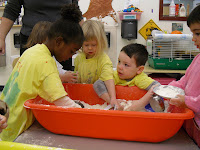The curriculum guides the development of a daily schedule that is predictable yet flexible and responsive to individual needs of the children. The schedule provides time and support for transitions, includes both indoor and outdoor experiences, and is responsive to a child's need to rest or be active.
The toddler schedule is flexible and changes with the needs of the children. To view the toddler schedule please click on the link located to the right of the page or click here.
2.A.08
Materials and equipment used to implement the curriculum
- reflect the lives of the children and families.
- reflect the diversity found in society, including gender, age, language and abilities.
- provide for children's safety while being appropriately challenging.
- encourage exploration, experimentation, and discovery.
- promote action and interaction.
- are organized to support independent use.
- are rotated to reflect changing curriculum and accommodate new interests and skill levels.
- are rich in variety.
- accommodate children's special needs.





The curriculum guides teachers to incorporate content, concepts, and activities that foster social, emotional, physical, language, and cognitive development and that integrate key areas of content including literacy, mathematics, science, technology, creative expression and the arts, health and safety, and social studies.
The schedule provides children learning opportunities, experiences, and projects that extend over the course of several days and incorporates time for: play, self-initiated learning, creative expression, large-group, small-group, and child-initiated activity.
The schedule in the toddler room allows for change and exploration. The schedule also allows for independent activities, small group and large group work. To view the schedule please click here.
2.A.12
The curriculum guides teachers to plan for children's engagement in play (including dramatic play and blocks) that is integrated into classroom topics of study.
Play is a very important part of our curriculum. Items in dramatic play and blocks are changed based on the children’s interest.












































